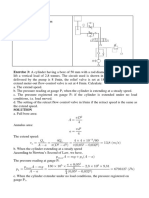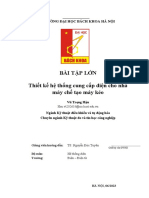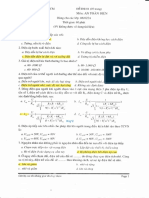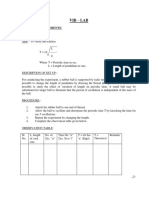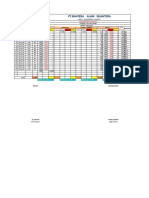Tutorial 3 - Analysis of Vehicle-Based Systems
Tutorial 3 - Analysis of Vehicle-Based Systems
Uploaded by
azizCopyright:
Available Formats
Tutorial 3 - Analysis of Vehicle-Based Systems
Tutorial 3 - Analysis of Vehicle-Based Systems
Uploaded by
azizOriginal Title
Copyright
Available Formats
Share this document
Did you find this document useful?
Is this content inappropriate?
Copyright:
Available Formats
Tutorial 3 - Analysis of Vehicle-Based Systems
Tutorial 3 - Analysis of Vehicle-Based Systems
Uploaded by
azizCopyright:
Available Formats
Analysis of
Material Transport Systems
▪ Analysis of vehicle-based systems
▪ From-to charts and network diagrams
▪ Rate of deliveries per vehicles
▪ Number of vehicles required
▪ The time for a typical delivery cycle consists of
1. Loading at the pickup station
2. Travel time to the drop off station
3. Unloading at the drop off station
4. Empty travel time of the vehicle between deliveries
Total cycle time per delivery per vehicle
Tc = TL + Ld/Vc + TU + Le/Ve
▪ Tc: delivery cycle time (min/del)
▪ TL: time to load at load station (min)
▪ Ld: distance between load and unload stations (m)
▪ Vc: carrier velocity when loaded (m/min)
▪ TU: time to unload at unload station (min)
▪ Le: distance the vehicle travels empty before next cycle
▪ Ve: velocity of empty vehicle (m/min)
Usage of delivery cycle time
Tc: can be used to determine 2 parameters
▪ Tc: delivery cycle time (min/del)
▪ Rate of deliveries per vehicle
▪ Number of vehicles required to satisfy a specified total
delivery requirement
Hourly rate of deliveries per vehicle
The hourly rate of deliveries per vehicle is 60min, adjusted
for any time losses during the hour, divided by the delivery
cycle time.
Rdv = AT / Tc = (60.A.Tf.E) / Tc
▪ Rdv: hourly delivery rate per vehicle (del/hour per vehicle)
▪ AT: available time in 1 hour with adjustments for time losses (min/hr)
▪ Tc: delivery cycle time (min/del)
▪ A: availability (vehicle not broken down or repaired)
▪ Tf: traffic factor (time losses due to traffic congestion)
▪ E: worker efficiency
Number of vehicles required
The total number of vehicles can be estimated by calculating
the total workload required and then dividing by the
available time per cycle.
Nc = WL / AT = Rf.Tc / AT = Rf / Rdv
▪ Nc: number of carriers required
▪ WL = work load (min/hr): total amount of work, expressed in
terms of time, that must be done in 1 hour = Flow rate X Tc
▪ AT: available time in 1 hour with adjustments for time losses (min/hr)
▪ Rf: specified flow rate of total deliveries per hour (del/hr)
▪ Tc: delivery cycle time (min/del)
▪ Rdv: hourly delivery rate per vehicle (del/hour per vehicle)
AGVS data
▪ Loading time at load station: 0.75 min - TL
▪ Unloading time at unload station: 0.50 min - Tu
▪ AGVS complete total 40 del/hr – Flow rate Unload
man
▪ Vehicle velocity: 50 m/min – Vc, Ve A
G
AGV guide path
V
▪ Availability: 95% -A 20
▪ Traffic factor: 90% -Tf 55
40
▪ Operator efficiency does not apply, E = 100%
▪ Determine: 20
▪ Travel distances loaded and empty A
G
▪ - Ld and Le ? Load
man
V
Direction of vehicle
movement
▪ Ideal delivery cycle time –Tc ?
▪ Number of vehicles required –Nc ?
Determining number of vehicles
required in this AGVS
▪ Loaded travel distance: Ld = 35 + 40 + 35 = 110m
▪ Travel distance empty: Le = 20 + 40 + 20 = 80m
▪ Ideal cycle time per delivery per vehicle Unload
man
▪ Tc = TL + Ld/Vc + TU + Le/Ve A
G
AGV guide path
V
▪ Tc = 0.75 + 110/50 + 0.50 + 80/50 20
▪ Tc = 5.05 min = Delivery cycle time 55
40
▪ Workload of AGVS:
▪ WL = flow rate X Tc = 40(5.05) = 202 min 20
▪ Available time: A
G
▪ AT = 60.A.Tf.E = 60(0.95)(0.90)(1.0) Load
man
V
Direction of vehicle
movement
▪ AT = 51.3 min per hour per vehicle
▪ Number of vehicles: Nc = WL/AT = 202/51.3 = 3.94
You might also like
- Cheat Sheet - Fluids ExamDocument1 pageCheat Sheet - Fluids ExamadehdNo ratings yet
- Đề thi HK221Document4 pagesĐề thi HK221Hải NguyễnNo ratings yet
- 03-Dynamic ProgrammingDocument13 pages03-Dynamic ProgrammingazizNo ratings yet
- Agv ProblemsDocument10 pagesAgv Problems19M647 - SRIRAM ANo ratings yet
- Cone NotesDocument5 pagesCone NotesamirlatNo ratings yet
- RainBird AutoCAD LegendDocument3 pagesRainBird AutoCAD LegendFlop ArghNo ratings yet
- GA Catalogue CA 500 GB 0501Document36 pagesGA Catalogue CA 500 GB 0501adst34No ratings yet
- AVSECDocument50 pagesAVSECAdythia Nusantara100% (1)
- Automatic Colour MixingDocument6 pagesAutomatic Colour MixingharrysinghNo ratings yet
- Bài tập tự động hóa sản xuất - 0005-0005Document1 pageBài tập tự động hóa sản xuất - 0005-0005Minh NhậtNo ratings yet
- Embedded SystemDocument28 pagesEmbedded SystemDevon Buckley86% (7)
- Chapter 2 - Discrete-State Control Part IIDocument63 pagesChapter 2 - Discrete-State Control Part IIVon JinNo ratings yet
- Sal Institute of Technology and Engineering Reserch Electrical DepartmentDocument1 pageSal Institute of Technology and Engineering Reserch Electrical DepartmentSachin ShikotraNo ratings yet
- BTL VuTrongHau 20202618Document89 pagesBTL VuTrongHau 20202618HauvuNo ratings yet
- MTTCNDocument296 pagesMTTCNCarlosNo ratings yet
- IpbalanceDocument1 pageIpbalancephuceltnNo ratings yet
- Es35 SW BrochureDocument4 pagesEs35 SW BrochureThái Trung TàiNo ratings yet
- Ydflp-6 V1Document26 pagesYdflp-6 V1Info PLSNo ratings yet
- 56 - A Learning Model For 8051 Microcontroller Case Study On Closed Loop DC Motor Speed Control PDFDocument7 pages56 - A Learning Model For 8051 Microcontroller Case Study On Closed Loop DC Motor Speed Control PDFhecirlene vieiraNo ratings yet
- Stability PDFDocument64 pagesStability PDFGlan DevadhasNo ratings yet
- Psim SVMDocument9 pagesPsim SVMNarendra ReddyNo ratings yet
- BJT - Examples & SolutionsDocument15 pagesBJT - Examples & SolutionsRobiul Haque BhuyanNo ratings yet
- HL6000 - ManualDocument103 pagesHL6000 - ManualtuongmanhchinhNo ratings yet
- A7677S Series Open-SDK Hardware Design - V1.00Document83 pagesA7677S Series Open-SDK Hardware Design - V1.00Nguyen HaNo ratings yet
- DENSO Robotics Datasheet HM-G SeriesDocument2 pagesDENSO Robotics Datasheet HM-G SeriesMarius Constantin100% (1)
- Quiz 1 - Battery and Starter - Xem Lại Lần Làm ThửDocument20 pagesQuiz 1 - Battery and Starter - Xem Lại Lần Làm ThửTran Thanh NhanNo ratings yet
- Transformer: Transformer Ratio Bridges Working PrincipleDocument13 pagesTransformer: Transformer Ratio Bridges Working PrincipleKamesh BujjiNo ratings yet
- Bidirectional Flyback Inverter WithDocument5 pagesBidirectional Flyback Inverter WithArceu CamposNo ratings yet
- 5.control of Manipulator by CPM2 Series PLCDocument5 pages5.control of Manipulator by CPM2 Series PLCIlija Petkovic0% (1)
- Home Assignments #3Document2 pagesHome Assignments #3Pham Thanh0% (1)
- Tele Traffic LectureDocument18 pagesTele Traffic LectureDramane BonkoungouNo ratings yet
- Ky Thuat Dieu Khien Tu Dong - Control System Technology-Lab Tutorials PDFDocument44 pagesKy Thuat Dieu Khien Tu Dong - Control System Technology-Lab Tutorials PDFwhaywhay whaywhayNo ratings yet
- A Sliding Mode Control For Robot ManipulatorDocument27 pagesA Sliding Mode Control For Robot ManipulatorauraliusNo ratings yet
- OmniRoller Holonomic Drive TutorialDocument11 pagesOmniRoller Holonomic Drive TutorialYoussef AbbasNo ratings yet
- MS150 - Servo Motor SystemDocument8 pagesMS150 - Servo Motor SystemEduardo AvilaNo ratings yet
- DethiTracNghiem An Toan Dien 3281Document28 pagesDethiTracNghiem An Toan Dien 3281duy taNo ratings yet
- Transient Stability Analysis: Evaluation of IEEE 9 Bus System Under Line Fault ConditionsDocument6 pagesTransient Stability Analysis: Evaluation of IEEE 9 Bus System Under Line Fault ConditionsNasiru BelloNo ratings yet
- LG RZ 21fb35 Chassis MC 049b PDFDocument29 pagesLG RZ 21fb35 Chassis MC 049b PDFSoultechLoveNo ratings yet
- Electronic Circuits Chapter 1: Op-Amp: Dr. Dung TrinhDocument24 pagesElectronic Circuits Chapter 1: Op-Amp: Dr. Dung TrinhNGUYÊN NGUYỄN TRUNGNo ratings yet
- Analog Electronics-3 PDFDocument39 pagesAnalog Electronics-3 PDFAbhinav Jangra100% (1)
- Electrical Machines Lab ManualDocument85 pagesElectrical Machines Lab ManualClause IandNo ratings yet
- Chapter4-Logical Design of Automation CircuitsDocument41 pagesChapter4-Logical Design of Automation CircuitsCao LoiNo ratings yet
- Thuat NguDocument43 pagesThuat NguCarlosNo ratings yet
- BLDC Motor Driver Specification Sheet: DC12 48V ( 10%), Rated Current 20ax2Document16 pagesBLDC Motor Driver Specification Sheet: DC12 48V ( 10%), Rated Current 20ax2Pablo VelaNo ratings yet
- 127.0.0.1 Downloaded 73496.pdf at Thu Jul 12 13:03:22 ICT 2012Document258 pages127.0.0.1 Downloaded 73496.pdf at Thu Jul 12 13:03:22 ICT 2012Trần Đình DũngNo ratings yet
- CODE XE DÒ LINE TRÁNH VẬT CẢN PDFDocument12 pagesCODE XE DÒ LINE TRÁNH VẬT CẢN PDFgiangNo ratings yet
- Buck ConverterDocument13 pagesBuck ConverterDinesh MahtoNo ratings yet
- ICL7107 Assembly GuideDocument9 pagesICL7107 Assembly GuideLaurentiu IacobNo ratings yet
- Component Detail Report 3288Document2 pagesComponent Detail Report 3288Богдан РудюкNo ratings yet
- Ed 4Document2 pagesEd 4Vaibhav KumarNo ratings yet
- SSED Solved Problems For Chapter 7Document6 pagesSSED Solved Problems For Chapter 7MINH NGUYỄN THẾNo ratings yet
- Vibration LabDocument38 pagesVibration Labtinkusk24No ratings yet
- Chapter 4. Actuators and Motion Control DevicesDocument84 pagesChapter 4. Actuators and Motion Control Devicesjohanna shaanyenengeNo ratings yet
- PBL1Document19 pagesPBL1Nguyen NamNo ratings yet
- MOS II - TUTORIAL SHEET Week 4 PDFDocument2 pagesMOS II - TUTORIAL SHEET Week 4 PDFShirishaVijayapuramNo ratings yet
- Flow Chart of Bisection Method: Start: Given a,b and ε u = f (a) ; v = f (b) c = (a+b) /2 ; w = f (c) yes no noDocument10 pagesFlow Chart of Bisection Method: Start: Given a,b and ε u = f (a) ; v = f (b) c = (a+b) /2 ; w = f (c) yes no noRaisqi Kun HartadiNo ratings yet
- Yellow DC 3V-6V Gear Motor For Intelligent Car TT Robot Motor Wheels TT MotorDocument5 pagesYellow DC 3V-6V Gear Motor For Intelligent Car TT Robot Motor Wheels TT MotorDwayne50% (2)
- PLC Exam Paper Mit ManipalDocument3 pagesPLC Exam Paper Mit ManipalAshley Jovian Correa50% (2)
- Newton Cotes in MATLABDocument2 pagesNewton Cotes in MATLABVicky Lavinia IINo ratings yet
- Tesla Coil ProjectDocument9 pagesTesla Coil ProjectAyush RanjanNo ratings yet
- EXAMPLE 1: Consider The AGVS Layout in Figure - Vehicles Travel Counterclockwise AroundDocument12 pagesEXAMPLE 1: Consider The AGVS Layout in Figure - Vehicles Travel Counterclockwise AroundQuỳnh Nguyễn100% (1)
- AGV Material Handling AnalysisDocument3 pagesAGV Material Handling AnalysisNukesh TiwariNo ratings yet
- 02-B&B For ILPDocument13 pages02-B&B For ILPazizNo ratings yet
- Principle of Metal Forming TheoryDocument50 pagesPrinciple of Metal Forming TheoryazizNo ratings yet
- Rev RobotDocument28 pagesRev RobotazizNo ratings yet
- Chapter4 e Slides - 4Document79 pagesChapter4 e Slides - 4azizNo ratings yet
- The Determinants: Mongi BLEL King Saud UniversityDocument30 pagesThe Determinants: Mongi BLEL King Saud UniversityazizNo ratings yet
- Linear System Equations: Mongi BLEL King Saud UniversityDocument24 pagesLinear System Equations: Mongi BLEL King Saud UniversityazizNo ratings yet
- ACCIDENTDocument51 pagesACCIDENTsanjay dalelaNo ratings yet
- 3 11 3 PDFDocument12 pages3 11 3 PDFEndashu TekalignNo ratings yet
- 41 Hilux (Cont. Next Page) : Power Source Abs (W/ VSC), TRC and VSCDocument4 pages41 Hilux (Cont. Next Page) : Power Source Abs (W/ VSC), TRC and VSCAnwar ZaibNo ratings yet
- 3911 LM (Exp 01.11.24)Document1 page3911 LM (Exp 01.11.24)nyckedz_ryvonNo ratings yet
- My BMW X1Document5 pagesMy BMW X1bperfect1No ratings yet
- Design and Fabrication of Compressed Air Vehicle: J.Tarun Kumar B.Gowtham KumarDocument5 pagesDesign and Fabrication of Compressed Air Vehicle: J.Tarun Kumar B.Gowtham KumarankNo ratings yet
- Glossary On Automobile Vocabulary in English, Swedish, Finnish, German, Bulgarian and GreekDocument18 pagesGlossary On Automobile Vocabulary in English, Swedish, Finnish, German, Bulgarian and GreekVeronicaGelfgrenNo ratings yet
- BMW E46 WorkSheetsDocument7 pagesBMW E46 WorkSheetsSalisbur100% (1)
- 1686912632360-Safety Circular 2023Document70 pages1686912632360-Safety Circular 2023political scienceNo ratings yet
- 12 Analysis of Road Traffic Accident Related of Geometric Design Parameters in Alamata Mehoni Hewane SectionDocument8 pages12 Analysis of Road Traffic Accident Related of Geometric Design Parameters in Alamata Mehoni Hewane Sectionemer_quezonNo ratings yet
- Operating Department ReportDocument9 pagesOperating Department ReportAnish AnandNo ratings yet
- CNC Levers Kit Long A9620028-EnDocument6 pagesCNC Levers Kit Long A9620028-Enft6wmn5t2qNo ratings yet
- Pedestrians' Role in Road Accidents: 1. Introduction: Background of Vehicle-Pedestrian AccidentsDocument14 pagesPedestrians' Role in Road Accidents: 1. Introduction: Background of Vehicle-Pedestrian AccidentsDineshroyal DineshNo ratings yet
- Airfil Filters - Powered by Quality, Durability and ReliabilityDocument5 pagesAirfil Filters - Powered by Quality, Durability and ReliabilityMax SashikhinNo ratings yet
- Le TraDocument56 pagesLe TraThiru ManiNo ratings yet
- Pulsar 220 Workshop Manual ENGLISHDocument45 pagesPulsar 220 Workshop Manual ENGLISHTim ChesbroNo ratings yet
- Genie Gs-2646 SpecsDocument2 pagesGenie Gs-2646 SpecsKpChuaNo ratings yet
- Toll Plaza at Ch.81+150 - 07.09.21 - 1-8Document8 pagesToll Plaza at Ch.81+150 - 07.09.21 - 1-8Maninder ChaudharyNo ratings yet
- Flight Eticket A230530387852Document4 pagesFlight Eticket A230530387852Randa MaghrabiNo ratings yet
- Implementation of Commuter Rail System For Bangalore: I RitesDocument179 pagesImplementation of Commuter Rail System For Bangalore: I RiteskiwiNo ratings yet
- Module 5 Aerospace CertificationDocument26 pagesModule 5 Aerospace CertificationRahul LoharNo ratings yet
- Consump Alat Berat MV LUCKY LOONGDocument15 pagesConsump Alat Berat MV LUCKY LOONGCahmbedhugalNo ratings yet
- Sikorsky S70i Brochure PDFDocument8 pagesSikorsky S70i Brochure PDFAdichita Khaira RidatasatriaNo ratings yet
- Chrysler Killed My Mother HandoutDocument1 pageChrysler Killed My Mother HandoutchryslerkilledmymomNo ratings yet
- Multirole Fighter Aircraft Adp 2Document65 pagesMultirole Fighter Aircraft Adp 2Karthick. GNo ratings yet
- Dynamic Analysis of Mechanical Braking System: January 2019Document9 pagesDynamic Analysis of Mechanical Braking System: January 2019Brijith ShenoiNo ratings yet
- OTC AccreditedDocument73 pagesOTC AccreditedDanilo CarandangNo ratings yet
- A B1 F8 F7 F6Document4 pagesA B1 F8 F7 F6Mircea GilcaNo ratings yet
- RFC NSB TMS Report Executive SummaryDocument47 pagesRFC NSB TMS Report Executive SummaryAjayNo ratings yet

